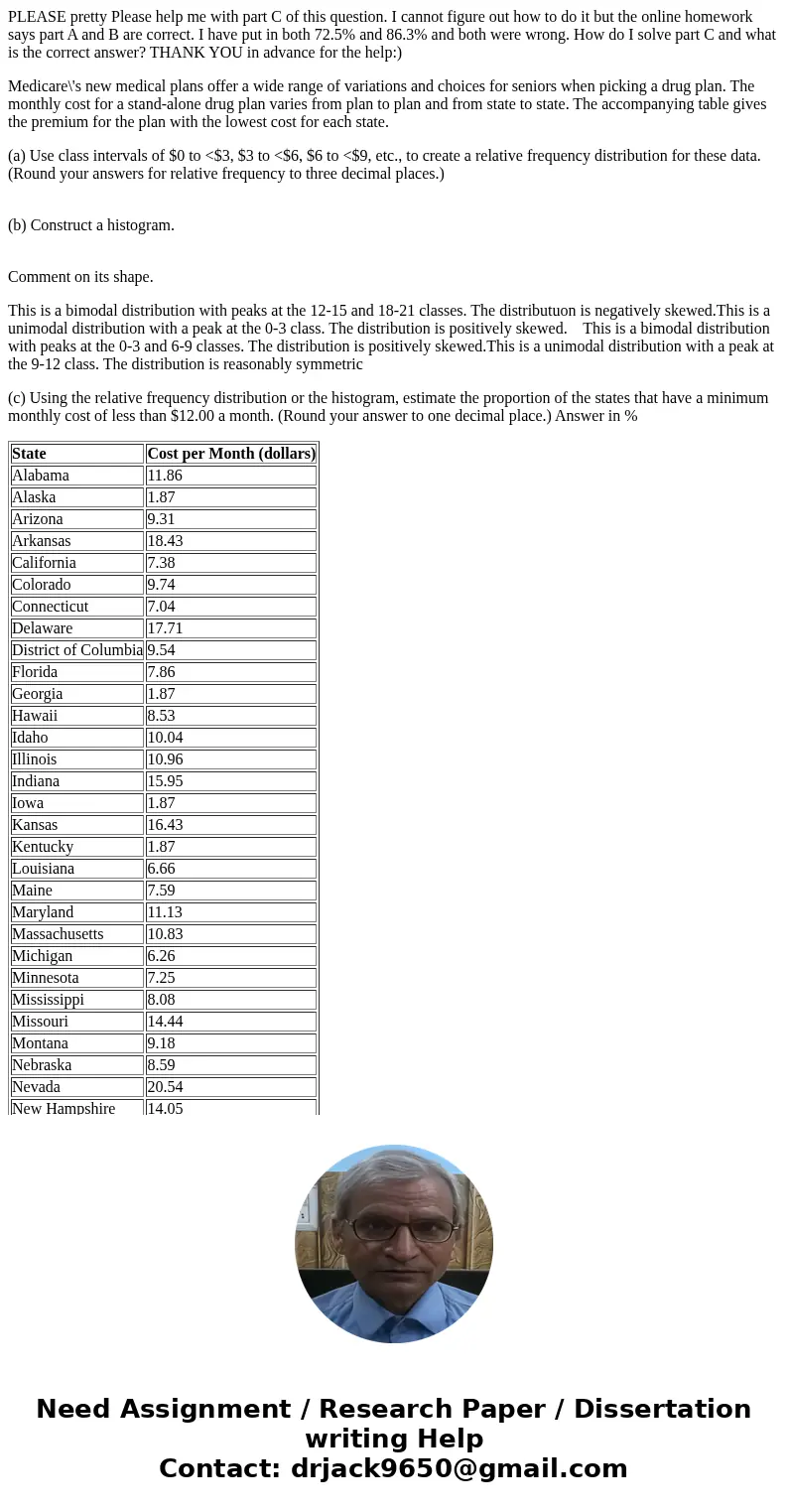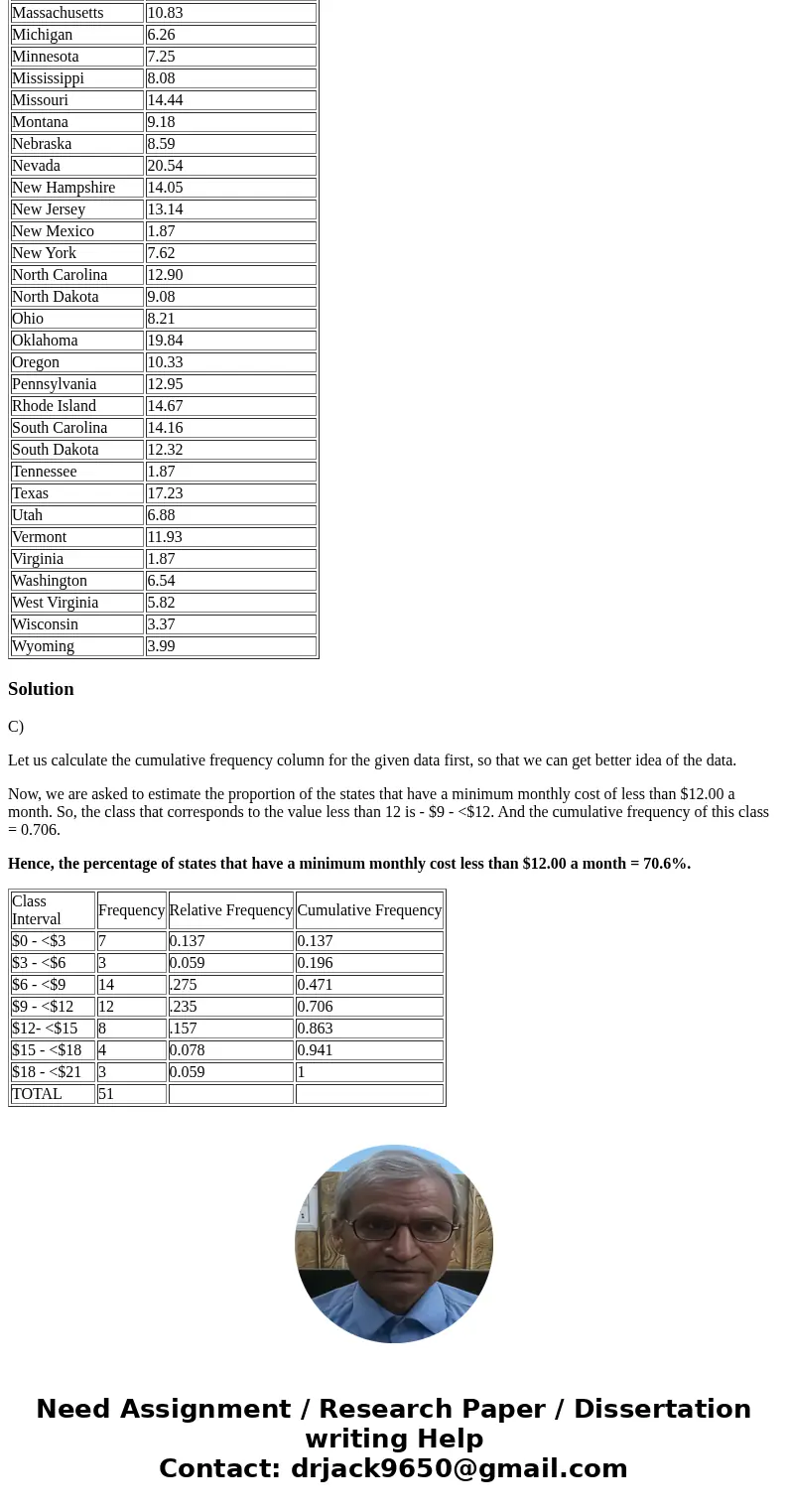PLEASE pretty Please help me with part C of this question I
PLEASE pretty Please help me with part C of this question. I cannot figure out how to do it but the online homework says part A and B are correct. I have put in both 72.5% and 86.3% and both were wrong. How do I solve part C and what is the correct answer? THANK YOU in advance for the help:)
Medicare\'s new medical plans offer a wide range of variations and choices for seniors when picking a drug plan. The monthly cost for a stand-alone drug plan varies from plan to plan and from state to state. The accompanying table gives the premium for the plan with the lowest cost for each state.
(a) Use class intervals of $0 to <$3, $3 to <$6, $6 to <$9, etc., to create a relative frequency distribution for these data. (Round your answers for relative frequency to three decimal places.)
(b) Construct a histogram.
Comment on its shape.
This is a bimodal distribution with peaks at the 12-15 and 18-21 classes. The distributuon is negatively skewed.This is a unimodal distribution with a peak at the 0-3 class. The distribution is positively skewed. This is a bimodal distribution with peaks at the 0-3 and 6-9 classes. The distribution is positively skewed.This is a unimodal distribution with a peak at the 9-12 class. The distribution is reasonably symmetric
(c) Using the relative frequency distribution or the histogram, estimate the proportion of the states that have a minimum monthly cost of less than $12.00 a month. (Round your answer to one decimal place.) Answer in %
| State | Cost per Month (dollars) |
| Alabama | 11.86 |
| Alaska | 1.87 |
| Arizona | 9.31 |
| Arkansas | 18.43 |
| California | 7.38 |
| Colorado | 9.74 |
| Connecticut | 7.04 |
| Delaware | 17.71 |
| District of Columbia | 9.54 |
| Florida | 7.86 |
| Georgia | 1.87 |
| Hawaii | 8.53 |
| Idaho | 10.04 |
| Illinois | 10.96 |
| Indiana | 15.95 |
| Iowa | 1.87 |
| Kansas | 16.43 |
| Kentucky | 1.87 |
| Louisiana | 6.66 |
| Maine | 7.59 |
| Maryland | 11.13 |
| Massachusetts | 10.83 |
| Michigan | 6.26 |
| Minnesota | 7.25 |
| Mississippi | 8.08 |
| Missouri | 14.44 |
| Montana | 9.18 |
| Nebraska | 8.59 |
| Nevada | 20.54 |
| New Hampshire | 14.05 |
| New Jersey | 13.14 |
| New Mexico | 1.87 |
| New York | 7.62 |
| North Carolina | 12.90 |
| North Dakota | 9.08 |
| Ohio | 8.21 |
| Oklahoma | 19.84 |
| Oregon | 10.33 |
| Pennsylvania | 12.95 |
| Rhode Island | 14.67 |
| South Carolina | 14.16 |
| South Dakota | 12.32 |
| Tennessee | 1.87 |
| Texas | 17.23 |
| Utah | 6.88 |
| Vermont | 11.93 |
| Virginia | 1.87 |
| Washington | 6.54 |
| West Virginia | 5.82 |
| Wisconsin | 3.37 |
| Wyoming | 3.99 |
Solution
C)
Let us calculate the cumulative frequency column for the given data first, so that we can get better idea of the data.
Now, we are asked to estimate the proportion of the states that have a minimum monthly cost of less than $12.00 a month. So, the class that corresponds to the value less than 12 is - $9 - <$12. And the cumulative frequency of this class = 0.706.
Hence, the percentage of states that have a minimum monthly cost less than $12.00 a month = 70.6%.
| Class Interval | Frequency | Relative Frequency | Cumulative Frequency |
| $0 - <$3 | 7 | 0.137 | 0.137 |
| $3 - <$6 | 3 | 0.059 | 0.196 |
| $6 - <$9 | 14 | .275 | 0.471 |
| $9 - <$12 | 12 | .235 | 0.706 |
| $12- <$15 | 8 | .157 | 0.863 |
| $15 - <$18 | 4 | 0.078 | 0.941 |
| $18 - <$21 | 3 | 0.059 | 1 |
| TOTAL | 51 |


 Homework Sourse
Homework Sourse